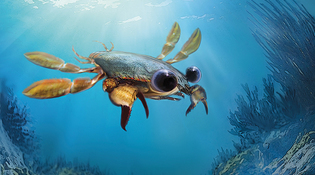 loading
loading
FindingsMove over, NemoTrying to make sense of an odd ancient crustacean.  Oksana Vernygora, UAlbertaView full imageAbout 95 million years ago, in shallow tropical seas that would one day become fossil-rich mountains in Colombia, there lived a crablike creature the size of a quarter. In 2005, Yale postdoc Javier Luque discovered an unexpected trove of some 70 members of the species, which would eventually be dubbed Callichimaera perplexa: the beautiful, perplexing chimera crab. But at first, Luque and his colleagues were baffled as to where the animal might fit in the crustacean Tree of Life. It had legs adapted for swimming rather than for crawling, a streamlined body, and enormous eyes with no sockets. As a whole, it was an anatomical mash-up, and it reminded Luque of the platypus—with its duckbill, fur, and beaver tail. He suspects that C. perplexa is a chimera: an amalgam in which some larval features persist into adulthood. “This is a real chimera crab that refused to grow up,” says Luque. Pixar and Disney, take note.
The comment period has expired.
|
|